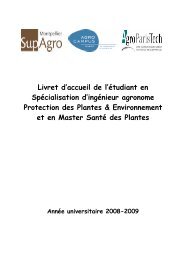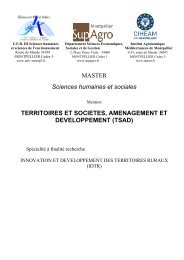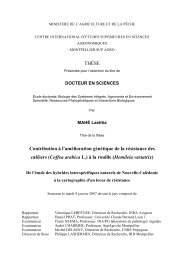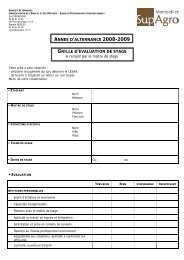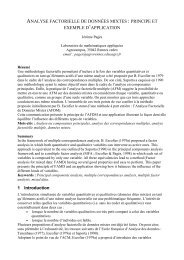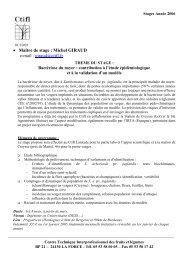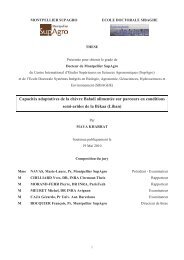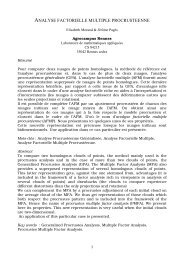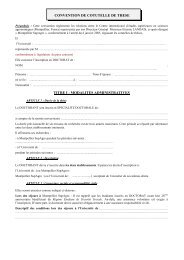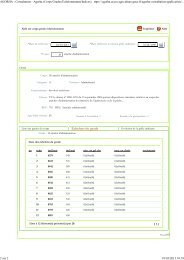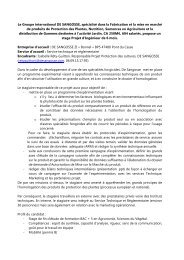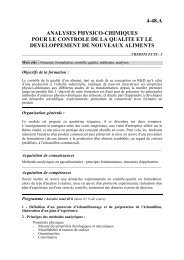Estimation of the extreme value index and high quantiles under ...
Estimation of the extreme value index and high quantiles under ...
Estimation of the extreme value index and high quantiles under ...
Create successful ePaper yourself
Turn your PDF publications into a flip-book with our unique Google optimized e-Paper software.
where Ẽj = Z j − t if Z j > t <strong>and</strong> 1 − F GP D (x) = ( )<br />
1 + γ −<br />
1<br />
1x γ 1<br />
. Then, <strong>the</strong> maximization <strong>of</strong><br />
σ<br />
this expression leads to a POT estimator for γ 1 which we fur<strong>the</strong>r denote by ˆγ t,ML.<br />
(c)<br />
Secondly, we can construct a new estimator based on k upper order statistics for instance<br />
within <strong>the</strong> framework <strong>of</strong> <strong>the</strong> QQ-plot regression technique. For example, in <strong>the</strong> case <strong>of</strong><br />
no-censoring, Beirlant et al. (1996) proposed an estimator <strong>of</strong> a real-<strong>value</strong>d <strong>index</strong> based on<br />
a generalized quantile plot, which takes over <strong>the</strong> role <strong>of</strong> <strong>the</strong> Pareto quantile plot in this<br />
more general setting. More precisely <strong>the</strong>y proposed to look at <strong>the</strong> graph with coordinates<br />
( n + 1<br />
)<br />
log , log UH j,n , j = 1, ..., n − 1,<br />
j<br />
with UH j,n = X n−j,n H X,j,n . Again this plot becomes ultimately linear for small j with<br />
slope approximating γ 1 . Then, one can construct several regression based estimators, such<br />
as<br />
ˆγ k,UH = 1 k∑<br />
log UH j,n − log UH k+1,n .<br />
k<br />
j=1<br />
From <strong>the</strong> above it appears natural to define a generalization <strong>of</strong> ˆγ k,UH to <strong>the</strong> censoring<br />
case as a slope estimator <strong>of</strong> <strong>the</strong> generalized quantile plot adapted for censoring<br />
( (<br />
− log 1 − ˆFn (Z n−j+1,n ) ) , log UH j,n) (c) , (10)<br />
(j = 1, ..., n − 1) where UH (c)<br />
j,n = Z n−j,n H (c)<br />
Z,j,n:<br />
ˆγ (c)<br />
1 ∑ kj=1<br />
k,UH = log UH (c)<br />
k<br />
1<br />
k<br />
j,n − log UH (c)<br />
k+1,n<br />
∑ kj=1<br />
. (11)<br />
δ n−j+1,n<br />
Using one <strong>of</strong> <strong>the</strong> abovementioned estimators ˆγ (c)<br />
.,. <strong>of</strong> γ 1 ≥ 0 we can now propose new<br />
estimators for <strong>the</strong> quantile x F,p , in <strong>the</strong> spirit <strong>of</strong> <strong>the</strong> one proposed by Dekkers et al. (1989)<br />
in <strong>the</strong> case <strong>of</strong> no-censoring:<br />
ˆx (c)<br />
p,t,. = t + ˆγ (c)<br />
.,. t<br />
( 1− ˆFn(t)<br />
)ˆγ (c)<br />
.,.<br />
p<br />
ˆγ (c)<br />
.,.<br />
− 1<br />
. (12)<br />
Under suitable assumptions, we establish <strong>the</strong> asymptotic properties <strong>of</strong> our estimators. We<br />
illustrate <strong>the</strong>ir behaviour in a small simulation study, but also in a practical insurance<br />
example.<br />
5



